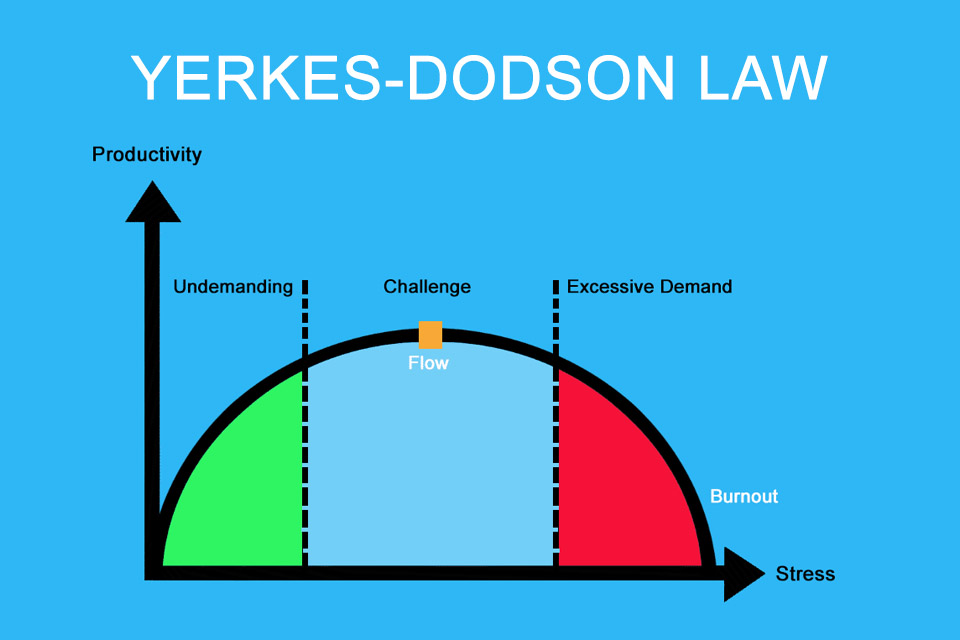What is the Yerkes-Dodson Law?
Smartpedia: The Yerkes-Dodson law describes a relationship between human arousal and performance. It is visualised with the help of the Yerkes-Dodson curve.
Yerkes-Dodson Law – the correlation of arousal and performance
Robert Mearns Yerkes¹ and John Dillingham Dodson², two US psychologists, discovered in 1908 that the individual performance of people with physiological or mental arousal only increases up to a certain point, but performance decreases when the arousal level becomes too high. This observation became known as the Yerkes-Dodson Law.
Since the optimal arousal level in humans is individual, Yerkes and Dodson did not have a direct starting point on how and to what level a performance can be increased in a concrete case, but nevertheless various insights can be derived from the observation.
This process is visualised as a bell-shaped curve, the Yerkes-Dodson curve, which is sometimes also referred to as an inverted U.
In flow at the vertex of the Yerkes-Dodson Curve
As a result of the findings of Yerkes and Dodson, tips and tricks are circulating in numerous books, magazines and blogs
- to increase arousal – also known as activation –
- or to reduce stress.
Some advisors try to increase the performance optimum, others to increase the amount of time in the maximum performance range. At the apex of the Yerkes-Dodson Curve, the individual as such seems to be simultaneously happiest and most efficient. This state is often referred to as flow³.
Findings of the Yerkes-Dodson Law
Put simply, the Yerkes-Dodson Law is a model of the relationship between stress and performance. It states that stress or arousal and performance are positively correlated, but only up to a certain point, after which more stress reduces performance.
The following insights can be derived from the Yerkes-Dodson Law or curve:
- Basically, any kind of thinking is considered an arousal process. Creativity techniques such as brainstorming or brainwriting use the amplification of arousal to increase thinking performance. Without arousal there is also no thinking performance.
- The rising part of the curve can be attributed to positive arousal and the falling part to negative arousal – in other words, stress.
- As arousal and effort increase, an individual’s productivity initially increases, but only up to the performance optimum at the apex of the curve. After the performance optimum, productivity declines.
- The course of the Yerkes-Dodson curve is determined by a reference to the concrete task. In simple, easy-to-learn or repetitive tasks, performance improves with increasing arousal. In complex, difficult and new tasks, the relationship between arousal and performance reverses after a point, and performance then decreases with increasing arousal.
- The Yerkes-Dodson curve is individual for each person. It can therefore be flat, pointed or round, symmetrical or asymmetrical. It is important to realise that both the resilience and susceptibility to stress as well as the performance optimum are different for each individual.
Examples of the application of the findings from the Yerkes-Dodson Law
Knowledge of the relationship between arousal and performance can have practical applications in a variety of fields, such as education, sport and business. Here are some examples:
- Teachers can use the findings to optimise the learning environment for their students. If students are not sufficiently engaged or challenged, they may become bored and disinterested in the material. On the other hand, if the material is too difficult or the workload is too heavy, students can become overwhelmed and stressed, which can affect their ability to learn. Since children are also individual, it naturally makes a lot of sense to “activate” them individually accordingly.
- Coaches can use the insights from the Yerkes-Dodson Law to optimise the performance of their athletes. If athletes are not sufficiently motivated or energetic, they may perform less well. On the other hand, if athletes are too nervous or anxious, their performance may suffer. By finding the right level of arousal for each athlete, coaches – and increasingly psychologists – can help them perform at their best.
- If employees are not sufficiently challenged or activated in their work, they may do their job by the book, leading to an increase in the number of mistakes, for example. If, on the other hand, employees are too stressed or overworked, their productivity may suffer. By finding the right level of arousal for each employee, employers can help them to be more productive and engaged. There are many ways to actively involve employees in processes such as brainstorming, developing strategies or making decisions.
All in all, the insights of the Yerkes-Dodson Law can help optimisation of performance in a variety of areas.
Criticism of the Yerkes-Dodson Law
Although the Yerkes-Dodson Law has played an important role in psychology for many years, it has been criticised in several respects as being too simplistic and outdated:
The law is often presented as a universal principle that applies to all tasks and situations. However, research has shown that the relationship between arousal and performance is more complex than a simple inverted U-curve. Different tasks and individuals may have different optimal levels of arousal.
The Yerkes-Dodson Law also does not explain how or why arousal affects performance. It does not account for individual differences, such as personality traits or cognitive abilities, that may influence a relationship between arousal and performance. It also negates the broader system or context in which the individual operates. For example, an individual’s performance on a task may be influenced by factors such as
- the quality of equipment or resources available,
- the support of colleagues or superiors,
- the goals of the organisation,
- the needs of customers, or
- the culture of the workplace.
It is therefore important to consider the interaction between the individual and the system in which they operate. As an interaction, it can have a significant impact on individual performance. Newer performance models take this broader perspective into account and emphasise the importance of understanding the complex interactions between the individual and their environment.
Impulse to discuss
How likely is it that the Yerkes-Dodson Law can be applied to all types of performance, such as creative or divergent thinking?
Notes:
[1] Robert Mearns Yerkes
[2] John Dillingham Dodson
[3] The happiness researcher Mihaly Csikszentmihalyi defines various prerequisites for flow: The task corresponds to one’s own abilities. It is challenging. You work in a concentrated way and block out everything else. There are clear goals with intermediate steps. Actions are followed by direct feedback.
Here you can find a video introducing the psychology of the Yerkes-Dodson Law.
If you like the article or would like to discuss it, please feel free to share it in your network. And if you have any comments, please do not hesitate to send us a message.
And here you can find additional information from our t2informatik Blog:



